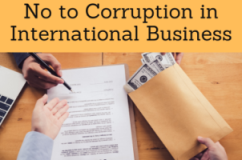Transparency International

Transparency International (Fight against corruption)
- Introduction to Transparency International
- Corruption and Globalization
- Corruption Perceptions Index
- Global Corruption Barometer
- Global Corruption Report
- Bribe Payers Index
- Principles of transparency and prevention of corruption for businesses
- Business Principles for Countering Bribery
- Case Study: Corruption Risk in Europe

The Subject “Transparency International” belongs to the following Online Programs taught by EENI Global Business School:
Course: No to Corruption in International Business.

All the Masters in International Business.
Doctorate International Business (DIB).
Languages:  (or
(or  Transparencia Internacional
Transparencia Internacional  Transparence Internationale).
Transparence Internationale).

Transparency International.
Transparency International (TI) was created in 1993 with the aim to fight against the global corruption. The vision of TI is “A world free of corruption: governments, politics, business, civil society and people.” Today is present in 100 countries (local chapters).
EENI wish to recognise publicly the significant efforts that Transparency International Is doing to fight the scourge of corruption.
According to Transparency International:
“Corruption is the abuse of the entrusted power for private gain.”
Some of his achievements are:
- International anti-corruption conventions (for example, the Integrity Pact)
- Corporate awareness in the struggle against corruption (Corruption Perceptions Index)
- Trials against corrupt people
Transparency International has developed an indicator based on the perceptions to measure the global corruption in the public sector (both administrative and political); the Corruption Perceptions Index, an essential tool for any company operating in the global market.
- Ten least corrupt countries: Denmark, Finland, New Zealand, Sweden, Singapore, Switzerland, Australia, Norway, Canada, and the Netherlands
- Ten most corrupt countries: Haiti, Venezuela, Iraq, Turkmenistan, Uzbekistan, Myanmar, Sudan, Afghanistan, North Korea, and Somalia
66% of the 176 economies ranked in the Corruption Perceptions Index of Transparency International has scored below fifty points (0 maximum level of corruption, 100 minima).
- Denmark, Finland, and New Zealand occupy the first place (90 points), while, Afghanistan, North Korea, and Somalia occupy the last place with eight point
- Spain is in 30th place (65 points) just behind Botswana!
Transparency International achievements affect foreign trade by strengthening legal and political framework.
Sample - Transparency International

(c) EENI Global Business School (1995-2024)
We do not use cookies
Top of this page



